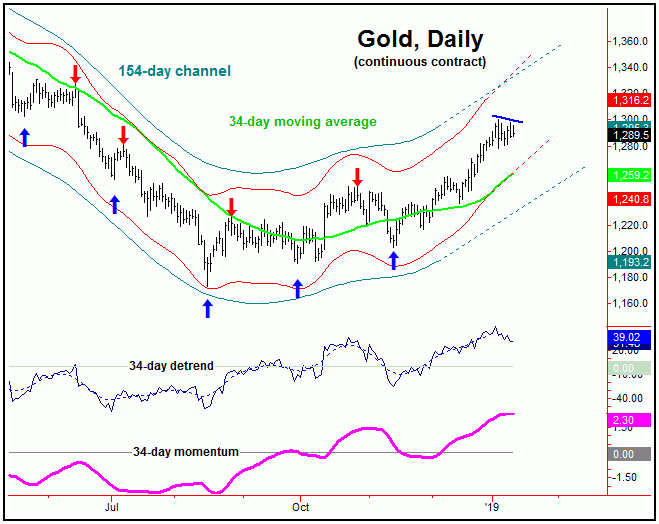Forecast: Gold Price Higher into February…But Down Into Spring

Last week's trading saw gold holding in a sideways-to-down consolidation, with the metal forming its low in Tuesday's session with the tag of the 1280.20 figure. From there, strength was seen into a Thursday high of 1298.00 - before backing off the same to end the week. The current consolidation is favored to end up as countertrend, to be followed by higher highs into the month of February.
Gold Near-Term Outlook
Moving into the new year, gold is currently deemed to be in a short-term correction phase with the smaller-degree cycles, which means all cycles from the 34-day wave on down. Here is our 34-day wave once again:
The short-term downward phase looks like it could end up playing out as a triangle - or a 'flag' - pattern, which are normally seen in an Elliott-wave 4. If correct, we should expect new highs to follow in a wave 5 - then to work on the next mid-term decline phase into what is anticipated to be the Spring of this year. Support to the move down looks to be at or into the lower channel line, around the 1267-1270 area (February, 2019 contract). If it can't hold there, then next support would be near the 34-day moving average, around the 1259-1260 level and rising.
In terms of patterns, the probabilities strongly favor the current downward phase of the 34-day cycle to end up as a countertrend affair, due again to the configuration of the larger 72, 154 and 310-day cycles - with the next mid-term peak expected to come from the smaller two waves. In terms of price, a countertrend decline simply means that the metal should remain above the last decent swing low, which is the 1236 bottom, seen back in mid-December.
Gold, Mid-Term
The chart above shows the dominant mid-term cycle for gold, which is the 154-day wave; the smaller 72-day component is not shown. As noted earlier, once the current short-term decline phase is complete, the odds will favor higher highs into what is projected to be the early- February timeframe, a move which should set the metal up for its first larger correction phase of 2019.
In terms of price, there are two key levels of interest to complete the mid-term rally, with the first being the 1311 figure, which is the 61% retracement of the move down from the February, 2018 peak to the August, 2018 bottom. Above that, a more key figure comes in at the 78% retracement level of 1349, which is also at or near the current 154-day channel top.
Stepping back then, higher highs into February - if seen as expected - should set gold up for what could be its largest decline of this year. In terms of time, the next trough for the 72 and 154-day cycles is projected for the April or May timeframe, with the minimum expected magnet to that decline being the 154-day moving average. Having said that, there is the full potential for a drop back to test the August, 2018 low of 1173, though that remains to be seen.
The dominant weekly cycle (chart, below) agrees with all of the above, and would be looking for February strength to give way to weakness into mid-Spring. I will be going over the weekly cycle in more detail in a special 2019 outlook.
Gold Timing Index
In looking at the mid-term picture for gold prices, our best indicator for the mid-term is our Gold Timing Index, which is shown again on the following chart:
As mentioned last weekend, the Gold Timing Index will tend to diverge from a new price low or low at mid-term peaks - even though this is not always the case. However, with the indicator having recently followed price to a new high, the probabilities do strongly favor any short-term correction to end up as a countertrend affair, and - if correct - the move is expected to give way to higher highs in the coming weeks, before the next mid-term peak attempts to form.
U.S. Stock Market
As for a quick take on the position of the U.S. stock market (as measured by the S&P500 index), I wrote in several articles that a larger-degree correction phase was coming due - and was projected to play out into the Autumn of 2018. That decline was expected to play out with the 180 and 360-day time cycles, with the smaller 180-day component shown on the chart below:
With the above said and noted, the 180 and 360-day waves most likely troughed back in late-December, though we can't rule out some type of re-test of that bottom in the coming weeks. Having said that, our mid-term assumption is that a rally back to the 200-day moving average or higher is likely in progress, though we expect that move to end up as an eventual countertrend affair - due to the configuration of the larger four-year cycle, which is shown on our next chart:
As pointed out in a prior article, the SPX looks to be in a much larger ABC correction phase with this four-year cycle, with the decline into the December bottom being wave 'A' of the move - and with wave 'B' likely in force off the same. In terms of price, the 200-day moving average is the ideal minimum magnet, though the move overall is anticipated to end up as countertrend - holding below the September, 2018 peak of 2940.91 on the SPX. If correct, an eventual drop back to lower lows should be seen in wave 'C' - which would bottom the four-year wave for what is expected to be a rally of 70-100% into the 2022 or 2023 timeframe.
Jim Curry
The Gold Wave Trader
http://goldwavetrader.com/
http://cyclewave.homestead.com/
********






















